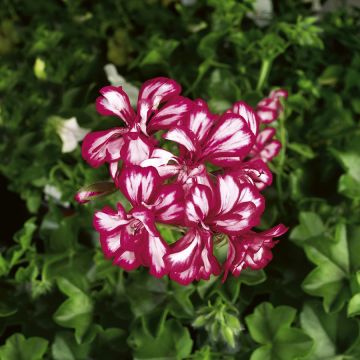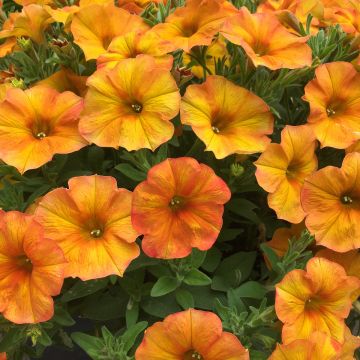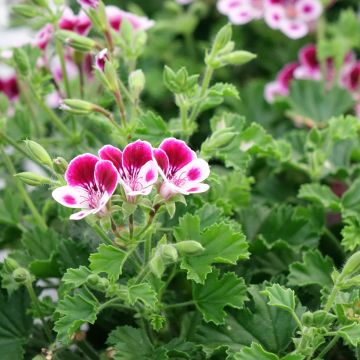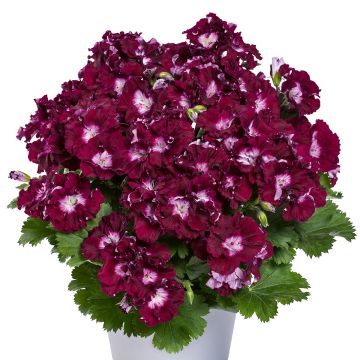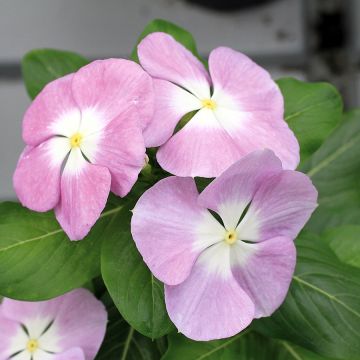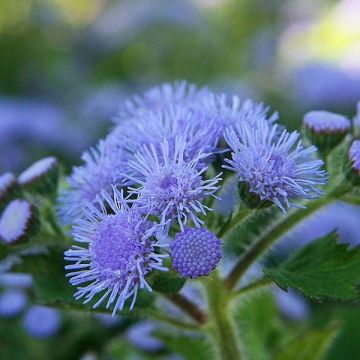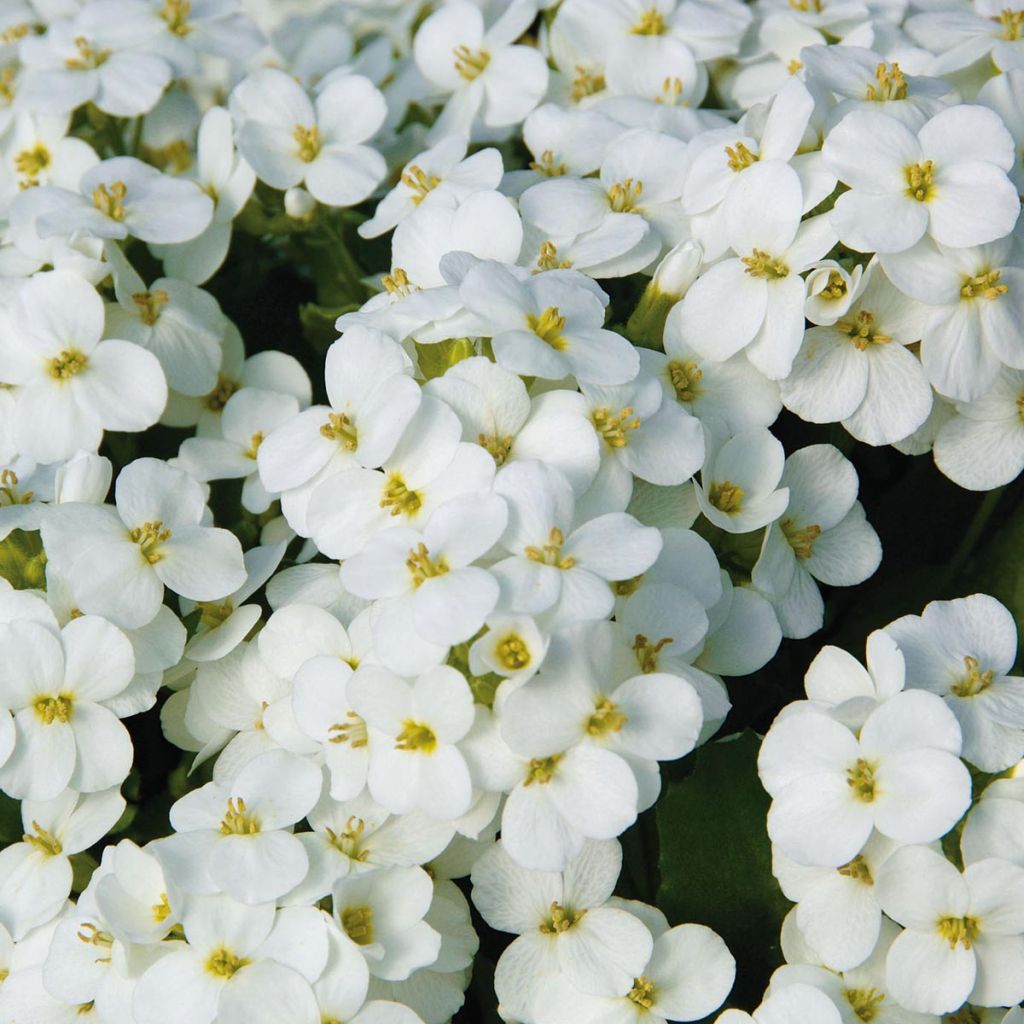

Arabis caucasica Alabaster
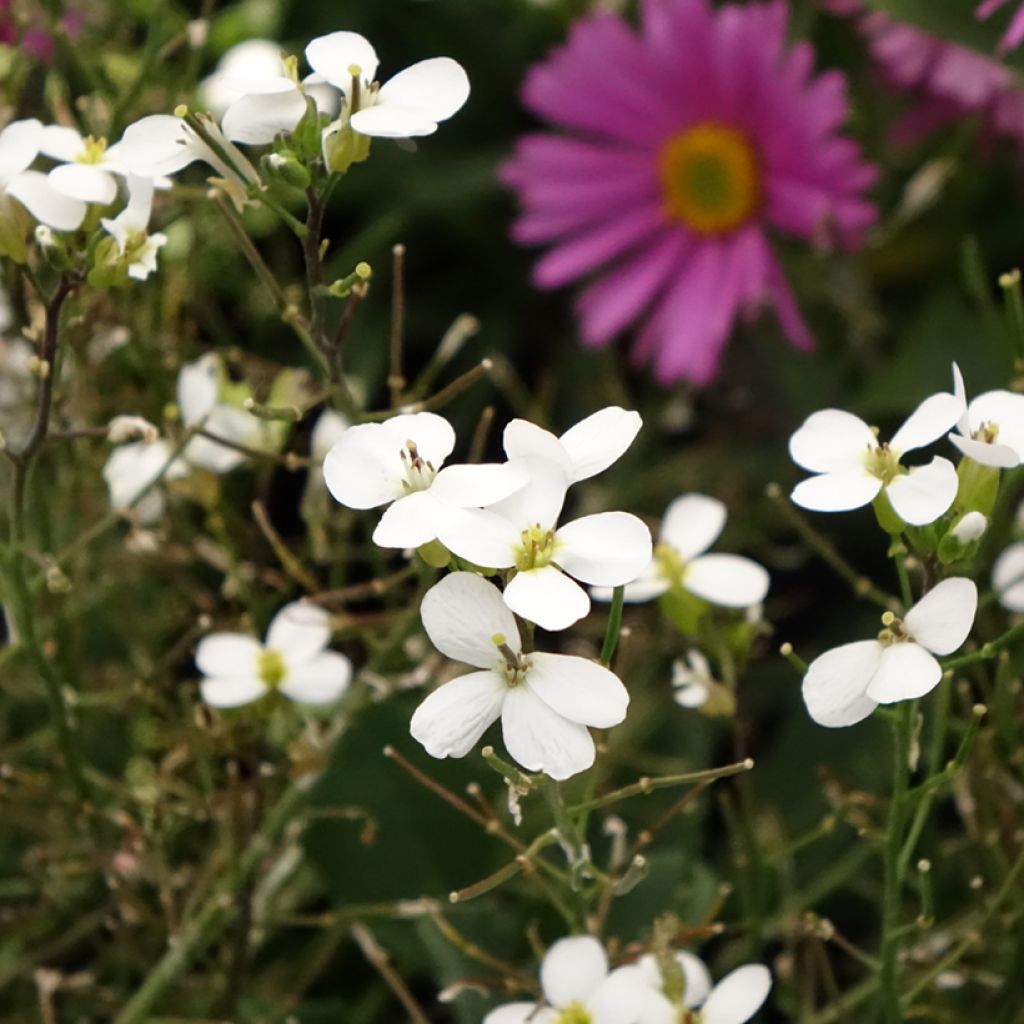

Arabis caucasica Alabaster
Arabis caucasica Alabaster
Arabis caucasica Alabaster 'Inaraalaba'
Mountain Rock Cress, Alpine Rock Cress, Alpine Rockcress, Caucasus Rockcress, Wall Rock Cress
Received in November 23, planted immediately. 2 young plants out of 3 taken.
Emilie , 31/05/2024
Special offer!
Receive a €20 voucher for any order over €90 (excluding delivery costs, credit notes, and plastic-free options)!
1- Add your favorite plants to your cart.
2- Once you have reached €90, confirm your order (you can even choose the delivery date!).
3- As soon as your order is shipped, you will receive an email containing your voucher code, valid for 3 months (90 days).
Your voucher is unique and can only be used once, for any order with a minimum value of €20, excluding delivery costs.
Can be combined with other current offers, non-divisible and non-refundable.
Home or relay delivery (depending on size and destination)
Schedule delivery date,
and select date in basket
This plant carries a 6 months recovery warranty
More information
We guarantee the quality of our plants for a full growing cycle, and will replace at our expense any plant that fails to recover under normal climatic and planting conditions.
Would this plant suit my garden?
Set up your Plantfit profile →
Description
The Arabis caucasica 'Alabaster' is a first-class hybrid for winter and spring decoration for pots and containers on balconies and terraces. This perennial with a spreading habit is very decorative thanks to its long-lasting flowers in alabaster white.
The 'Alabaster' Caucasian Rock Cress is a sterile hybrid, recently created in Germany: it is unique in that it has larger flowers and a longer flowering period than other varieties, as it does not wear itself out producing seeds. These qualities make it particularly suitable for use in pots and containers, combined with other biennials such as pansies, primroses, violas...unlike these, it is a perennial and can be replanted in the garden after flowering. Its superb pure white colour, simple and elegant, will brighten up any display!
A very hardy perennial plant, the Arabis alpina subsp. caucasica 'Alabaster' forms a cushion of evergreen foliage with a grey-green colour. Planted in autumn, it develops during winter to form a perfectly round ball, which will be covered with flowers from mid-March to mid-May. Typical of the Brassicaceae family (also known as "Crucifers"), the flowers are formed by 4 cross-shaped petals. They reach nearly a centimetre in diameter and completely cover the foliage during two months of uninterrupted flowering!
Native to the Caucasus Mountains, the rock cress thrives in well-drained soil or compost in full sun and requires little water. In the garden, it will colonize rockeries and low flowering walls without overwhelming them, and can be used as ground cover or as a border plant. This early and very easy-to-grow perennial combines well with basket-of-gold (Alyssum saxatile) and snow-in-summer (Cerastium tomentosum) which follow in its footsteps, as well as wallflowers, wall bellflowers, perennial stocks, candytufts, etc...
Note: Attention, our young plug plants are professional products intended for experienced gardeners: upon receipt, transplant them as soon as possible, in pots, containers, or directly in flower beds.
Report an error about the product description
Arabis caucasica Alabaster in pictures
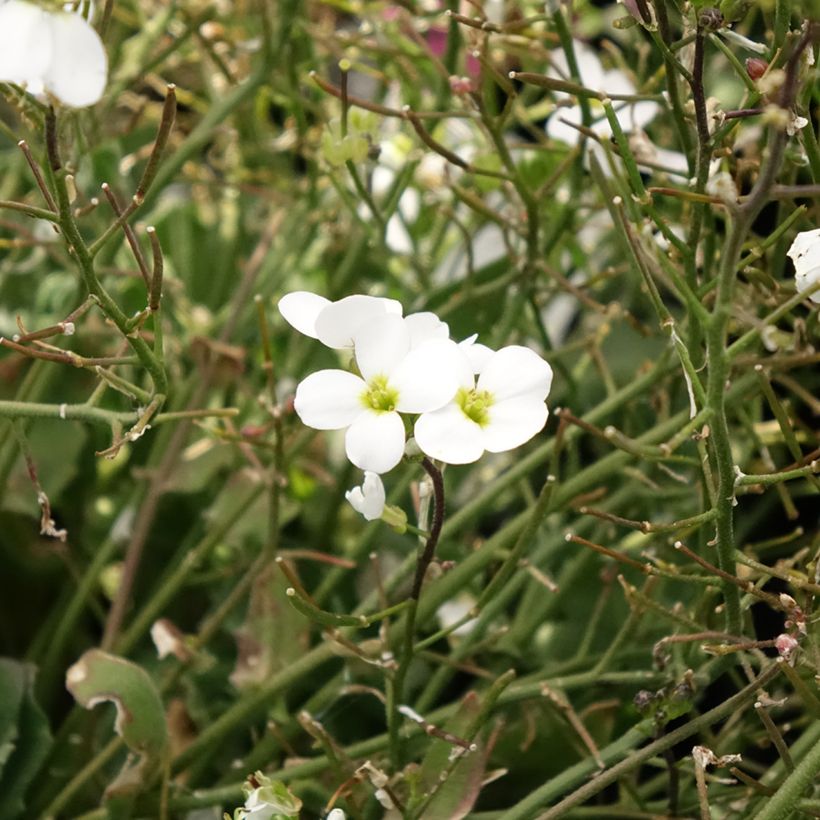

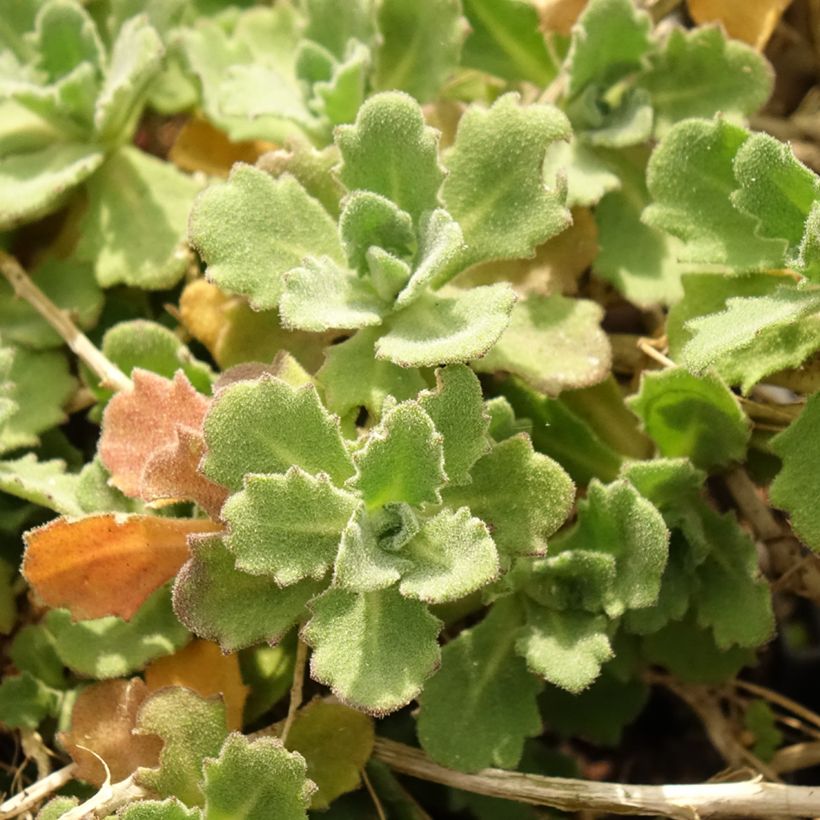

Flowering
Foliage
Plant habit
Botanical data
Arabis
caucasica
Alabaster 'Inaraalaba'
Brassicaceae
Mountain Rock Cress, Alpine Rock Cress, Alpine Rockcress, Caucasus Rockcress, Wall Rock Cress
Cultivar or hybrid
Planting and care
The young plug plants of Arabis caucasica 'Alabaster' should be planted in pots and containers or directly into the ground in well-prepared and improved soil. Plant them as soon as possible after receiving them, in September-October. If the intended location is not yet ready or the conditions are not favourable for planting (heavy rain or excessively dry soil), you can let them grow on in pots for 4 to 6 weeks. After planting, you can lightly pinch out the tip of the plant between your thumb and forefinger to remove the terminal bud and stimulate branching (optional).
In pots and containers, use a good, well-draining compost for flowering plants (with a lot of bark or perlite, for example) and enriched with slow-release fertilizer. The top of the root ball should be level with the soil. Water thoroughly at planting and during the following weeks, as the young plants can dry out quickly. However, do not overwater! Use containers with drainage holes and empty the saucer 10 minutes after watering. Remember to water, even during winter, if it doesn't rain or if the container is placed in a sheltered spot. Do not water during frosty periods.
Once growth starts up again, in late February or early March, and throughout the flowering period, apply a liquid fertilizer for flowering plants 1 to 2 times a week when watering. Once flowering has finished, the plants in pots can be replanted in the garden in full sun.
Planting period
Intended location
Care
-
, onOrder confirmed
Reply from on Promesse de fleurs
Similar products
Haven't found what you were looking for?
Hardiness is the lowest winter temperature a plant can endure without suffering serious damage or even dying. However, hardiness is affected by location (a sheltered area, such as a patio), protection (winter cover) and soil type (hardiness is improved by well-drained soil).

Photo Sharing Terms & Conditions
In order to encourage gardeners to interact and share their experiences, Promesse de fleurs offers various media enabling content to be uploaded onto its Site - in particular via the ‘Photo sharing’ module.
The User agrees to refrain from:
- Posting any content that is illegal, prejudicial, insulting, racist, inciteful to hatred, revisionist, contrary to public decency, that infringes on privacy or on the privacy rights of third parties, in particular the publicity rights of persons and goods, intellectual property rights, or the right to privacy.
- Submitting content on behalf of a third party;
- Impersonate the identity of a third party and/or publish any personal information about a third party;
In general, the User undertakes to refrain from any unethical behaviour.
All Content (in particular text, comments, files, images, photos, videos, creative works, etc.), which may be subject to property or intellectual property rights, image or other private rights, shall remain the property of the User, subject to the limited rights granted by the terms of the licence granted by Promesse de fleurs as stated below. Users are at liberty to publish or not to publish such Content on the Site, notably via the ‘Photo Sharing’ facility, and accept that this Content shall be made public and freely accessible, notably on the Internet.
Users further acknowledge, undertake to have ,and guarantee that they hold all necessary rights and permissions to publish such material on the Site, in particular with regard to the legislation in force pertaining to any privacy, property, intellectual property, image, or contractual rights, or rights of any other nature. By publishing such Content on the Site, Users acknowledge accepting full liability as publishers of the Content within the meaning of the law, and grant Promesse de fleurs, free of charge, an inclusive, worldwide licence for the said Content for the entire duration of its publication, including all reproduction, representation, up/downloading, displaying, performing, transmission, and storage rights.
Users also grant permission for their name to be linked to the Content and accept that this link may not always be made available.
By engaging in posting material, Users consent to their Content becoming automatically accessible on the Internet, in particular on other sites and/or blogs and/or web pages of the Promesse de fleurs site, including in particular social pages and the Promesse de fleurs catalogue.
Users may secure the removal of entrusted content free of charge by issuing a simple request via our contact form.
The flowering period indicated on our website applies to countries and regions located in USDA zone 8 (France, the United Kingdom, Ireland, the Netherlands, etc.)
It will vary according to where you live:
- In zones 9 to 10 (Italy, Spain, Greece, etc.), flowering will occur about 2 to 4 weeks earlier.
- In zones 6 to 7 (Germany, Poland, Slovenia, and lower mountainous regions), flowering will be delayed by 2 to 3 weeks.
- In zone 5 (Central Europe, Scandinavia), blooming will be delayed by 3 to 5 weeks.
In temperate climates, pruning of spring-flowering shrubs (forsythia, spireas, etc.) should be done just after flowering.
Pruning of summer-flowering shrubs (Indian Lilac, Perovskia, etc.) can be done in winter or spring.
In cold regions as well as with frost-sensitive plants, avoid pruning too early when severe frosts may still occur.
The planting period indicated on our website applies to countries and regions located in USDA zone 8 (France, United Kingdom, Ireland, Netherlands).
It will vary according to where you live:
- In Mediterranean zones (Marseille, Madrid, Milan, etc.), autumn and winter are the best planting periods.
- In continental zones (Strasbourg, Munich, Vienna, etc.), delay planting by 2 to 3 weeks in spring and bring it forward by 2 to 4 weeks in autumn.
- In mountainous regions (the Alps, Pyrenees, Carpathians, etc.), it is best to plant in late spring (May-June) or late summer (August-September).
The harvesting period indicated on our website applies to countries and regions in USDA zone 8 (France, England, Ireland, the Netherlands).
In colder areas (Scandinavia, Poland, Austria...) fruit and vegetable harvests are likely to be delayed by 3-4 weeks.
In warmer areas (Italy, Spain, Greece, etc.), harvesting will probably take place earlier, depending on weather conditions.
The sowing periods indicated on our website apply to countries and regions within USDA Zone 8 (France, UK, Ireland, Netherlands).
In colder areas (Scandinavia, Poland, Austria...), delay any outdoor sowing by 3-4 weeks, or sow under glass.
In warmer climes (Italy, Spain, Greece, etc.), bring outdoor sowing forward by a few weeks.


































